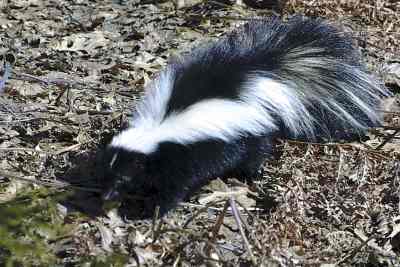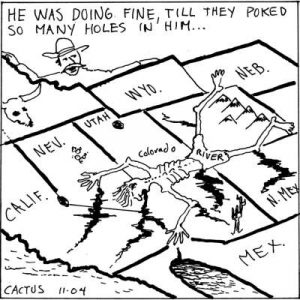Article by Lynda La Rocca
Wildlife – November 2004 – Colorado Central Magazine
IF YOU WERE SADDLED with a name that means “noxious, pestilential, or foul exhalation,” you, too, might develop defense mechanisms as powerful as those of Mephitis mephitis, the striped skunk.
You gotta feel sorry for this little black-and-white- furred creature. Even its non-Latin name has become synonymous in the English language with such undesirable characteristics as obnoxiousness and cheating.
Frankly, skunks get a lot of bad press, considering that 70 percent of their diet is made up of insects considered harmful to humans, including aphids, scorpions, and black widow spiders. These omnivorous, opportunistic feeders also eat mice, rats, moles, birds’ eggs, lizards, frogs, acorns, seeds–and cat food when they can get it, as the publishers of Colorado Central Magazine inadvertently discovered while trying to live-trap a stray cat that had taken up residence in a backyard shed.
After this kitty produced one litter, Ed and Martha decided to have the cat spayed. But first, they had to catch her. And that meant renting a live-trap from the local humane society, baiting it, and waiting for the wary feline to work up an appetite. She didn’t–but a skunk did, as Ed discovered early one morning.

Being a law-abiding citizen, Ed knew that it’s against Colorado law to relocate or transport a striped skunk. (Which raises the question of why, then, would anyone bother to deliberately live-trap one, only to let it go again at the same capture site? Because he can?)
So Ed tossed a rug over the trap, tripped the door, and released the skunk, which–fortunately for the Quillens and their neighbors–didn’t feel threatened enough to produce a release of its own. [Or perhaps the animal was merely exhausted, since by the time he was discovered, the yard already had a disagreeable, but not stomach-turning, aroma.]
Although no longer biologically grouped with the Mustelidae family of weasels, martens, badgers, otters, and mink, the recently reclassified Mephitidae family share a key characteristic with their former relatives–scent or musk glands. Of the four Colorado skunk species–striped, eastern spotted, western spotted, and hog-nosed (the latter may no longer live here; no specimens have been reported in 50 years) –the striped skunk is the most common. But it’s not the most pungent. That honor goes to the spotted skunks, which are more high-strung than their cousins and therefore more likely to feel a need to defend themselves.
And that’s all the emission of that unforgettable odor is–the skunk’s very effective response to being threatened, surprised, or disturbed.
Skunks “spray,” releasing an oily, yellowish musk, only as a last resort; even they don’t like how they smell and won’t spray where they live, according to the Evergreen [Colorado] Animal Protective League. No surprise there. Skunk scent has been described as a combination of ammonia, sulfur, sewer gas, and garlic–a far cry from your standard aromatherapy.
Technically, this musk is called butylmercaptan, and it is similar to the chemical compound added to odorless natural gas to make it detectable. According to the Colorado Division of Wildlife, when a skunk feels threatened, the openings of a pair of musk glands on either side of the base of the tail pop up. Then muscles constrict to squirt the musk as a fine spray or a thick stream. The odor is strong enough to leave victims sneezing, choking, gagging, and gasping, even nauseated and vomiting. The spray is so caustic that if it hits the eyes, it can actually cause temporary blindness (for up to 15 minutes). As if one dose isn’t sufficient, skunks can “fire at will,” sending up to eight bursts of musk a distance of 12-15 feet, but once its musk is depleted, it takes at least a week for a skunk to “recharge” and build up a new supply.
To be fair, though, skunks give us (and our dogs) plenty of warning before they spray. Ed noticed this when “his” skunk raised the fur on its back and tail.
A skunk’s first line of defense is to flee from or avoid danger. When it can’t, it faces its adversary, fur erect and back arched, then stamps its front feet and shuffles backwards. If that doesn’t work, the skunk raises its tail and twists its body into a U-shape before letting loose. The western spotted skunk also lunges forward, bringing its front feet down and then drawing them back, before assuming the ultimate position–a “handstand” in which it balances on its front legs and “walks” toward the threat, hindquarters and tail raised and ready to squirt.
Although foxes, mountain lions, bobcats, and coyotes occasionally prey on skunks, these house-cat-sized stink bombs have few natural enemies. As the state DOW succinctly puts it, “. . . any animal large enough to kill a skunk is also smart enough not to bother.” One exception is the great horned owl, which relies on sight and hearing to capture its food. The owl’s less-developed sense of smell is its own best defense against getting “skunked”–or at least against noticing the effects of a direct hit. Owl nests sometimes exude a distinctive odor from the remains of skunks fed to the owlets.
Another danger is manmade. Because skunks are likely to react to approaching vehicles with threat postures, they are frequently struck and killed on roadways. This behavior may have given rise to the myth that skunks boldly “face down” vehicles rather than flee. The truth, however, is that skunks simply don’t realize their defenses are ineffective against objects lacking a sense of smell.
Striped skunks usually breed in February or March and a litter of 6-8 kits is born in May. By six weeks of age, the kits are already becoming pretty capable sprayers.
Skunks den in rock crevices, woodpiles, hollow logs, burrows dug by themselves or other animals, under buildings, and beneath decks and porches. Their offensive odor, coupled with the fact that they can harbor diseases like rabies, which is fatal without early treatment, makes skunks’ proximity to humans undesirable and at times, dangerous.
According to the federal Centers for Disease Control and Prevention, 2,282 cases of rabies in skunks were reported throughout the United States in the year 2001. Although none involved Colorado skunks, which generally have a low incidence of rabies, skunks should never be handled and certainly should never, ever be kept as pets.
So if you see a skunk, enjoy its antics from a distance. Don’t be a skunk yourself by bothering a creature that may remind you, in no uncertain terms, that there are consequences for being obnoxious.
Lynda La Rocca often finds wildlife in her Twin Lakes yard, but so far, no skunks.




